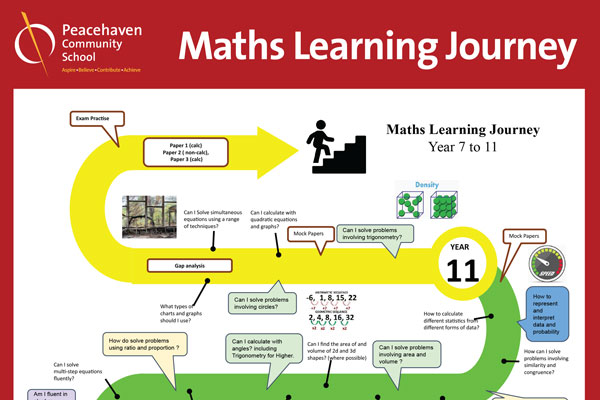
Maths
Curriculum Intent
At Peacehaven Community School, the Mathematics curriculum is crafted to foster a sense of creativity and interconnectedness, empowering students to tackle some of the most intriguing problems throughout history. Our approach aligns with the school's vision of providing outstanding education in a supportive environment by setting high expectations for our students and ensuring they develop a strong foundation in mathematics, which is vital for their future success in various fields.
Our curriculum emphasises reasoning and problem-solving skills, cultivating a logical mindset that transcends numbers and shapes. We are dedicated to nurturing students' curiosity and appreciation for the beauty and power of mathematics, ultimately preparing them for the ever-changing world. By promoting inclusivity, resilience, and community partnership, we inspire our students to achieve excellence and make excellent progress.
We believe that every student can excel in mathematics, and our evidence-based teaching methods facilitate a personalised learning experience that caters to individual needs, abilities, and interests. With our innovative and challenging curriculum, we strive to create confident, curious, and proficient mathematicians who will actively contribute to society as responsible global citizens.
Ezra Leonce - Head of Maths - ezra.leonce@swale.at
KS3
Students have maths for 4 lessons each week.
Year 7
Terms 1 and 2
Students will cover sequences, algebraic notation, equality and equivalence, place value and ordering and FDP equivalence.
Terms 3 and 4
Students will cover addition and subtraction, multiplication and division, fractions and percentages of amounts, directed number and addition and subtraction of fractions.
Terms 5 and 6
Students will cover constructing, measuring and using geometric notation, developing geometric reasoning, developing number sense, sets and probability and prime numbers and proof.
Medium Term Plans
Term 3
Fractions, Decimals and Percentages
Term 4
Constructions Geometric Reasoning & Notation
Year 8
Terms 1 and 2
In autumn terms students will look at Proportional reasoning exploring ideas of ratio scale and multiplicative change. In addition they will also learn about muliplying and dividing fractions here. Following on form this students will explore different representations of information, including working in the cartesian plan about representing data and tables leading to probabilitiy.
Terms 3 and 4
Here students build on their algebraic understanding to explore ideas with brackets and building on their knowledge of equations begun in year 7. In addition to this they will be exposed to other algebraic techniques such as indices and sequences. After this students will work on developing their number sense with a look at fractions and percentages and standard form.
Terms 5 and 6
In these terms students will explore geometry and data. They will start of looking at angles in parallel lines and in polygons, then build onto and work with trapezia, circles and look at transformations. Finally they will look at reasoning with data by looking at the handling data cycle.
Medium Term Plans
Term 3
Representing Data / Number Sense
Term 4
Geometry
Year 9
|
Terms 1 and 2 Terms 3 and 4. Terms 5 and 6 Medium Term Plans |
KS4
|
Students have maths for 5 lessons a week in year 10 and 4 lessons a week in year 11, OCR is the exam board and their specification can be found here: https://www.ocr.org.uk/qualifications/gcse/mathematics-j560-from-2015/ |
Year 10
|
In terms 1&2 students will cover column vectors, transformations, area of triangles and quadrilaterals, area and circumference of circles, solving linear equations, solving quadratic equations, simultaneous equations, inequalities, laws of indices, 4 operations with fractions, calculations with pi and standard form. In terms 3&4 students will cover F.D.P. in proportion, ratio, percentage change, factors, multiples and primes, prime factor decomposition, LCM, HCF and Venn diagrams, powers and roots. In terms 5&6 students will cover co-ordinates, plot graphs, equation of a straight line, real life graphs, 3D solid names and terminology, plans and elevations, volume of a prism, surface area and cones and spheres. Medium Term Plans |
Year 11
|
In terms 1&2 students will length, mass and capacity, speed and density, upper and lower bounds, sets, possibility space, tree diagrams, sequence rules, finding the nth term, special sequences, properties of quadratic functions, sketching functions, real life graphs, compound units, direct proportion, inverse proportion and growth and decay In terms 3&4 students will undertake revision applicable to their group and tier of entry specific to their needs In term 5 students will work on exam technique, revise and undertake their first GCSE paper Medium Term Plans |
Homework
Homework is a crucial part of our learning in maths and is set using our online homework platform: Sparx maths. This platform works by using an algorithm that creates bespoke tasks for each student and provides them with the space at home to consolidate their learning from the current taks, and to review previous learning, to aid memory of key information from previous topics.
As part of our teaching we review the homework tasks and use them to inform our planning in lessons.Homework is set once a week on a Tuesday for each class. For KS3 the length is 30 mins whereas for KS4 the length of homework is 45 mins.
To support students with their homework, each task has a short videos to explain the question and support with any background knowledge that they need to answer the question. In addition, each week we set optional tasks are set to give students access to more practise at the same level of difficulty, or extension work to help students to really expand their learning and push themselves.
Additional Resources
|
https://www.mathsgenie.co.uk/gcse.html Maths genie is a website where there are topic based questions with solutions and video clips to support understanding. It is free and split by grade to allow appropriate material to be used depending on ability. |
Key Words
The only way to learn mathematics is to do mathematics
PAUL HALMOS

